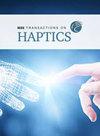优化触觉盲文和形状显示的 3D 打印模型。
IF 2.8
3区 计算机科学
Q2 COMPUTER SCIENCE, CYBERNETICS
引用次数: 0
摘要
市场上现有的可刷新盲文显示器(RBD)功能有限,价格昂贵,阻碍了盲人和视障人士在教学中的使用。这促使我们为教育机构开发一种多功能、结构紧凑、价格低廉的可刷新盲文显示器,以提升教学和学习体验。我们建议开发 BLISS(盲文字母和交互式形状屏幕),这是一种新型的点字显示器,BLISS 采用独特的盲文单元配置排列,一次最多可容纳六个字母,并通过重复使用盲文针来容纳形状。为了确定最佳规格,包括尺寸、盲文单元间距和针脚配置,我们制作并评估了 3D 打印套件,模拟 BLISS 如何显示字母和形状。我们与 8 名盲人和视力受损者测试了 36 种不同的 3D 打印套件,发现传统盲文间距不足以准确显示形状。因此,BLISS 将采用一种新颖的设计,利用针脚配置,将额外的针脚升高以显示形状,将其降低以显示盲文字母,从而提供双模式操作。我们的研究结果表明,BLISS 具有在同一刷新显示器上同时显示盲文字母和形状的潜力,提供了一种新颖、紧凑和经济高效的解决方案。本文章由计算机程序翻译,如有差异,请以英文原文为准。
3D-Printed Models for Optimizing Tactile Braille & Shape Display
Existing market-available refreshable Braille displays (RBDs) offer limited functionality at a high cost, hindering accessibility for individuals with blindness and visual impairment for teaching and learning purposes. This motivates us to develop a multi-functional, compact, and affordable RBD tailored for educational institutes to enhance teaching and learning experiences. We propose the development of BLISS (Braille Letters and Interactive Shape Screen), a novel RBD, that BLISS presents a unique configuration arrangement of Braille cells that accommodates up to six letters at a time and shapes by reusing the Braille pins. To determine the optimal specifications, including size, Braille cell spacing, and pin configuration, we fabricated and evaluated 3D-printed sets, mimicking how BLISS would display letters and shapes. We tested 36 variants of 3D-printed sets with 8 individuals with blindness and visual impairment and found that conventional Braille spacing is insufficient for accurately representing shapes. Hence, BLISS will introduce a novel design that uses a pin configuration to raise the extra pins to present shapes and lower them for Braille letters, providing dual-mode operation. Our findings show the potential of BLISS to display both Braille letters and shapes on the same refreshable display, offering a novel, compact, and cost-effective solution.
求助全文
通过发布文献求助,成功后即可免费获取论文全文。
去求助
来源期刊

IEEE Transactions on Haptics
COMPUTER SCIENCE, CYBERNETICS-
CiteScore
5.90
自引率
13.80%
发文量
109
审稿时长
>12 weeks
期刊介绍:
IEEE Transactions on Haptics (ToH) is a scholarly archival journal that addresses the science, technology, and applications associated with information acquisition and object manipulation through touch. Haptic interactions relevant to this journal include all aspects of manual exploration and manipulation of objects by humans, machines and interactions between the two, performed in real, virtual, teleoperated or networked environments. Research areas of relevance to this publication include, but are not limited to, the following topics: Human haptic and multi-sensory perception and action, Aspects of motor control that explicitly pertain to human haptics, Haptic interactions via passive or active tools and machines, Devices that sense, enable, or create haptic interactions locally or at a distance, Haptic rendering and its association with graphic and auditory rendering in virtual reality, Algorithms, controls, and dynamics of haptic devices, users, and interactions between the two, Human-machine performance and safety with haptic feedback, Haptics in the context of human-computer interactions, Systems and networks using haptic devices and interactions, including multi-modal feedback, Application of the above, for example in areas such as education, rehabilitation, medicine, computer-aided design, skills training, computer games, driver controls, simulation, and visualization.
 求助内容:
求助内容: 应助结果提醒方式:
应助结果提醒方式:


